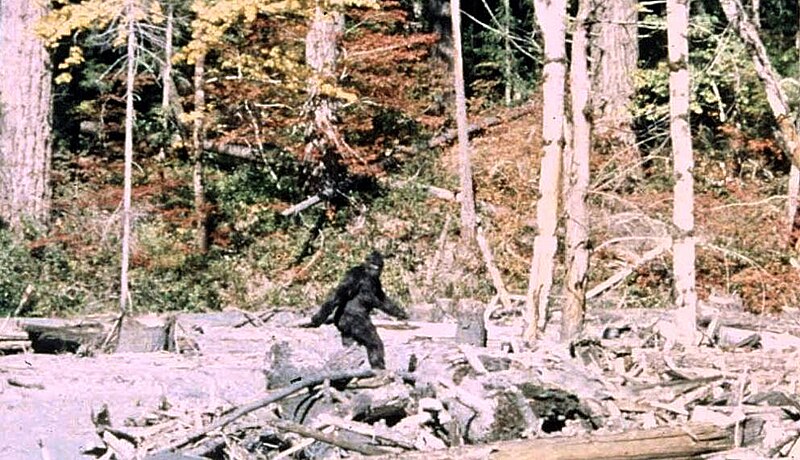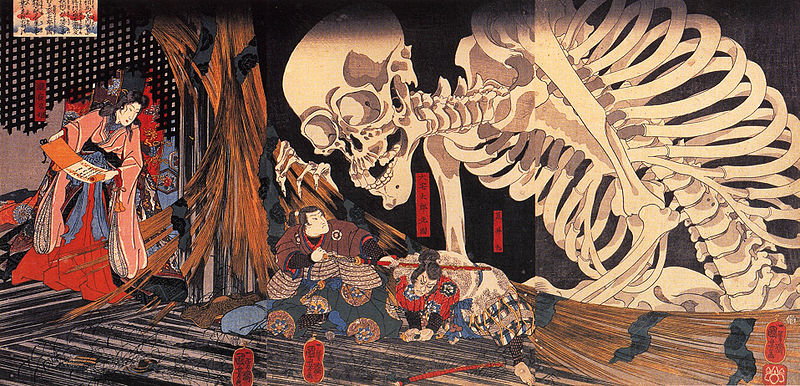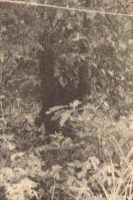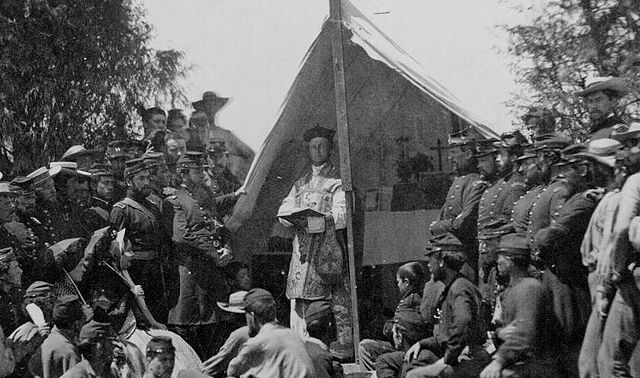
Bigfoot, also known as Sasquatch and Grassman, can be found in Native American folklore and in modern sightings. I know many people who have seen Bigfoot or something like it. Not far from my hometown, History Channel filmed a documentary about the Grassman version of Bigfoot. I’ve been all over those forests and had seen nothing except deer and bobcats and some Grassman hunters.
According to Britannica, Sasquatch is “a large, hairy, humanlike creature believed by some people to exist in northwestern United States and western Canada. It seems to represent the North American counterpart of the Himalayan region’s mythical monster, the Abominable Snowman, or Yeti.”
The first Native American stories of Bigfoot were recorded in Canada by J.W. Burns. After hearing whispers of “wild men” and “fathers of the forest”, he tracked down a man named Peter Williams, a Native American who lived on the Chehalis Reserve. Peter’s account of finding a giant man covered in thick hair while hunting. He had mistaken the man for a bear at first. The wild man jumped up and chased Peter through the woods, all the way back to Peter’s home (Geller, 2018). Other stories feature sightings of female giants.
Bigfoot gained its name in 1958 when Gerald Crew found a set of footprints in California. The prints were too large to be human despite having human characteristics. Gerald made plaster casts of the prints. His story was picked up by The Humboldt Times and the Associated Press. Later, the brother of the man who ran the construction site admitted the prints were a hoax (Geller, 2018). But the label “Bigfoot” still stuck and later became associated with other sightings.
Some people consider Bigfoot as surviving Neanderthal or some other cousin of the human family. If Bigfoot exists, it may be a giant sloth people see. Giant sloth used to live throughout North America, and they match the description of Bigfoot when they stand on their hind legs. I’ve seen giant sloth skeletons in museums. Plus, they went extinct relatively recently, so it is possible a population of them survives in the denser forests of the continent. As Britannica summarizes Bigfoot’s description: “Sasquatch is variably described as a primate ranging from 6 to 15 feet (2 to 4.5 metres) tall, standing erect on two feet, often giving off a foul smell, and either moving silently or emitting a high-pitched cry. Footprints have measured up to 24 inches (60 cm) in length and 8 inches (20 cm) in width.”
What is a Yokai?

Yokai are a class of supernatural creatures or phenomena in Japanese folklore. They spread across a variety of things: monsters, ghosts, spirits, events, objects, and more. As Foster (2015) describes them:
In a sense, yokai is nothing more than a convenient label to indicate a whole range of otherwise ineffable experiences that might, in English, be translated with the words spirits, goblins, phantoms, spectors, sprites, shape-shifters, demons, fantastic beings, numinous occurrences, the supernatural, and perhaps most commonly today, monsters.
Yokai is a modern term. During the Heian period such strangeness was called mono-no-ke or “mysterious thing”. The word yokai became used in academia in the early 1900s with the work of Inoue Enryo. However, Yamagita Kunio’s work made it popular (Foster, 2015).
Yamagita Kunio is considered to be the father of folklore studies in Japan. Westerners like Lafcadio Hearn and Basil Hall Chamberlain encouraged and inspired him to look into Japan’s folklore. While throughout the centuries some books about Japan’s various mononoke existed, Kunio sparked serious modern study in Japan. He suggested, which is still debated according to Foster, that yokai are kami that have “degraded” over time. As people worshiped them less, they devolved into lesser entities. As Foster (2015) writes:
Both kami and yokai reflect a way of thinking often called animistic, meaning that the things in the world around us–rocks, rivers, even musical instruments–can possess animating forces or spirits…On one end, where yokai cluster, we have everything that seems troublesome, undesirable, unworshipped. The other end contains helpful, desirable, and worshipped things–generally called kami. But these are extremes, and any individual entity can move along this continuum.
Yokai aren’t bad. They can do bad things, but they can also be beneficial too. Kitsune, the Japanese fox, fall into this category. In some stories, like the story of Tamamo (of which my book Tamamo is a retelling), has the fox as a negative being. Yet, kitsune also closely associates the the kami Inari, either being Inari herself/himself (depending on the historical period) or being a servant of Inari. In this, kitsune is good.
Okay, with all the background out of the way, we can get back to our original question.
Is Bigfoot a Yokai?
Now, I’m hesitant to merge two different cultural traditions. Bigfoot comes from an entirely different folklore tradition than yokai. Bigfoot doesn’t factor into American culture at the same level as yokai do. Yokai tangle deep into Japanese culture and history; whereas Bigfoot is merely a fun story or a mysterious being used to teach people caution when out in the woods.
Let’s look at Sasquatch’s general traits: elusive, mysterious, threatening, benevolent, unworshiped. People attribute strange sounds, tree branch constructions, and similar unexplained events to Bigfoot. I know a person who told me they saw something matching Bigfoot’s description materialize from a strange light and then disappear again. It made me think of Star Trek’s transporter. This person isn’t prone to stories and was skeptical about the event.
In any case, Sasquatch’s general traits match that of yokai based on Foster’s description of yokai. However, unlike yokai, Sasquatch can’t be placated or purified through human ritual. Foster (2015) writes that yokai:
Through appropriate human action, such as rituals of pacification, a rough spirit might be transformed into a gentle spirit. The very thing that threatens human enterprises and society (aratama, yokai) can be changed into a beneficial and cooperating power (nigitama, kami) in these same enterprises.
Bigfoot can’t be encouraged to help using rituals. It acts on its own accord.
If you look at Bigfoot’s traits, it can fit within the yokai continuum. However, Bigfoot belongs to a different cultural context…for now. Japan has its own giants with similar descriptions as Bigfoot; it is possible the North American Bigfoot stories could fold into Japan’s resident forest giant yokai. If this would happen then, yes, Bigfoot could be a yokai. As it stands now, Bigfoot isn’t a yokai. Rather, it is yokai-like.
Yokai is a cultural construct of Japan, and the construct doesn’t transfer into North American cultures. Without the cultural context, the idea of yokai breaks down. Understanding the different folklore traditions provides valuable insight into how people think about the world. Notice, however, that there are more similarities than differences!
So is Bigfoot a yokai? No. Bigfoot belongs to its own folklore tradition.
References
Foster, Michael Dylan (2015) The Book of Yokai: Mysterious Creatures of Japanese Folklore. California, University of California Press.
Geller (2018) Bigfoot. Mythology.net, https://mythology.net/mythical-creatures/bigfoot/.
Britannica. Sasquatch. https://www.britannica.com/topic/Sasquatch




The Native American Tribe that I’m enrolled in has a preserved area restricted to tribal members only. It is a mountain area within the Rocky Mountains. My cousin’s mother camps at the top of the mountain preservation area. Her sons go stay with her sometimes. And they have all sorts of stories of seeing bigfoot and little people and white animals. Many of these creatures are basically spirits that can take on forms to protect greater spirits within the forest. If you are getting too close to something they consider very sacred, you will be chased out. Neighboring tribes have songs to call on bigfoot. Bigfoot is a spirit and a protector who takes on the form of a tall hairy being. Little people are about 2 feet tall and serve the same purpose. It is rare to see walking trees. Walking trees are the ultimate protecters of sacred beings within the forest. Orange orbs are also common with bigfoot as they use them to scare people away. A lot of Japanese folklore is eerily similar to the stories that Elders told Native American children. Which is why I love Japanese stories and cartoons. There are Elders alive today that recall hearing creeks and streams singing during the night and day. Or hearing trees talk. But they said that with colonization came the eradication of our spiritual bond with the earth. And as their parents started to teach western culture. The spiritual culture faded. Spirits will only make themselves known if they want to be seen.
Thank you for sharing! I’ve read many anthropologists trace the lineage of Native Americans and Japan’s Jomon people back to a common group. That might help explain the connections among their stories. Of course, Carl Jung would add that these stories point toward the collective unconscious of humanity.
Culture certainly affects how we perceive things. A very level-headed Filipino friend insists that she once saw a “Manananggal”, a woman’s upper body floating though the air while dragging her entrails. And a young man near where I lived in Tokyo insisted that he once saw several ghostly people emerge from a lake in the middle of a nearby park during the night. And I (along with someone else) saw *something* once, when I was in my teens… though I chalk it up to a more likely misinterpretation. Yokai, perhaps. But it may depend upon where one defines the source of “reality”.
Every culture has a framework to describe the indescribable oddities we sometimes encounter. Some frameworks are richer than others. My question is: why are some frameworks richer like Japan and China’s?
Perhaps it seems that way due to much popular and accessible artwork? Living in far northern Thailand for a few years, there were rich stories and portrayals of “Nats”, “Naga”, “Apsara”, “Nang Mai”, “Krasue”, and various Hungry Ghosts and Deva. Many of them somewhat parallel Japanese portrayals of Kami and nature spirits. There’s even a tradition of tying colored ribbons onto certain types of spirit-inhabited trees.
BTW, back on May 5 of this year, I wrote some about Princess Takiyasha’s conjuring of the “gashadokuro” portrayed in that Utagawa Kuniyoshi woodblock. You may already know the backstory; there’s a culturally and historically associated location in Tokyo.
That’s a good point. Native Americans, for example, have rich folklore that remains mostly unknown even to those of us who live alongside them. Perhaps that’s because their art and stories aren’t as accessible.
For those who want to read Kumi’s article here it is: The Princess and the Bureaucrat